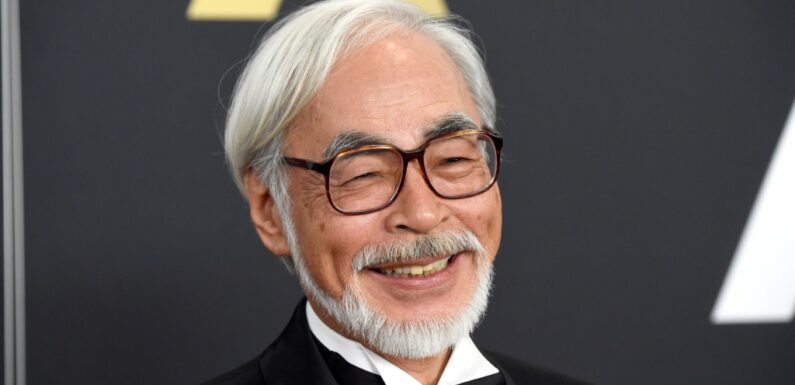
Acclaimed anime director Hayao Miyazaki’s latest film, The Boy And The Heron (aka How Do You Live?), hit Japanese theatres on Friday, July 14 with no advance publicity apart from a title and a poster.
The move was a deliberate ploy by Studio Ghibli head Toshio Suzuki to encourage audiences to see Miyazaki’s first film in a decade without preconceptions. “A poster and a title – that’s all we got when we were children. I enjoyed trying to imagine what a movie was about, and I wanted to bring that feeling back,” Suzuki told Japanese broadcaster NHK.
Related Stories

Gkids Acquires North America On Hayao Miyazaki's 'The Boy And The Heron' (AKA 'How Do You Live?') As Film Takes Flight In Japan Amid Unique Non-Campaign

'My Neighbour Totoro': Royal Shakespeare Company Brings Back Smash Stage Adaptation Of Studio Ghibli Classic For Second Season In London
ComScore reported a $13.2M opening weekend for the film, distributed by Toho, with IMAX saying it set a new three-day opening record with $1.7M from 44 screens.
Reactions from Japan-based critics, none of which were offered advance screenings, are mixed but mostly favourable.
Anime News Network gave the film an ‘A’ rating overall, praising it for its themes and the quality of the animation, but gave it a B+ for the story, about a young boy called Mahito during the Second World War, which it said was “exceedingly predictable”.
“What’s not predictable is everything else,” the reviewer Richard Eisenbeis said. “The world Mahito travels through is unlike any seen before – even in Miyazaki’s other similar films. From oceans with monstrous fish to cities full of man-eating parrots – you’re never sure where the film is going next or who Mahito will meet there.
“Of course, half of what makes the fantasy elements so powerful is the animation,” Eisenbeis continued. “It’s truly astounding. Every frame of this film feels like a separate work of art—one that only becomes grander when put together as part of the greater whole. It’s a film you could watch a hundred times and still discover new things in the background of any given scene.”
Based on a Genzaburo Yoshino novel that is said to have had a special impact on Miyazaki as a child, the film follows Mahito after his mother is killed during the war-time fire bombings of Tokyo.
After Mahito’s father marries his mother’s younger sister, the family moves to the countryside, where he meets a talking heron, who claims his mother is still alive and waiting to be rescued in a mysterious tower near his home. When his stepmother disappears into the tower, Mahito decides to enter it despite warnings to stay away in order to rescue her.
Writing for the BBC, Tokyo-based journalist Matt Schley says: “The film is full of Miyazaki’s signature obsessions, quirks and thematic concerns. There are the usual visual treats, like cute yet eerie creatures, great-looking food and gravity-defying flights of fancy – primarily hand-drawn and moving with the fluidity and sense of weight that mark the master animator’s work.
“Thematically, as in films like Kiki’s Delivery Service and Spirited Away, How Do You Live is a coming-of-age tale in which a child must overcome his selfishness and learn to live for others.”
Time Out Japan’s Emma Steen said that, despite the film’s G rating, it has a “markedly more mature tone and provides more unsettling moments than the likes of Ponyo and My Neighbor Totoro.
“At one point, Mahito deliberately injures himself to evade school bullies and there are freaky creatures, including anthropomorphic man-eating parakeets, to rival No-Face and the Stink Spirit in Spirited Away.”
Steen also said the “plethora of ideas occasionally distracts from the storytelling” but concluded that it’s a “mature, complex masterpiece” and “worth the wait”.
The 82-year-old Miyazaki has announced his retirement before, only to start work on The Boy And The Heron, but Suzuki has previously said that he was making the film as a farewell gift to his grandson.
Many Japanese reviewers have noted that Miyazaki’s own family escaped the bombing of Tokyo for the Japanese countryside and that his father worked in a fighter plane factory, just like Mahito’s father in the film. Miyazaki has also spoken about how he had an especially close relationship with his mother, which inspired the strong female characters in his films.
Nobody outside Japan has been able to see the film and its international release strategy is still being set, increasing the air of mystery. Gkids has acquired the film for North America and is expected to release it later this year.
Must Read Stories
Faith Series & Rebel Wilson Movie Granted Exemption To Continue Filming Amid Strike
Without An ‘RRR’ Or ‘K.G.F.’, India’s Box Office Falls 15% In The First Half Of 2023
Christopher Nolan Pauses Filmmaking; Craig Mazin On Studios “Hurting” People
Cruise Pic Sets Franchise U.S. 5-Day Opening Record With $80M, $235M WW
Read More About:
Source: Read Full Article



